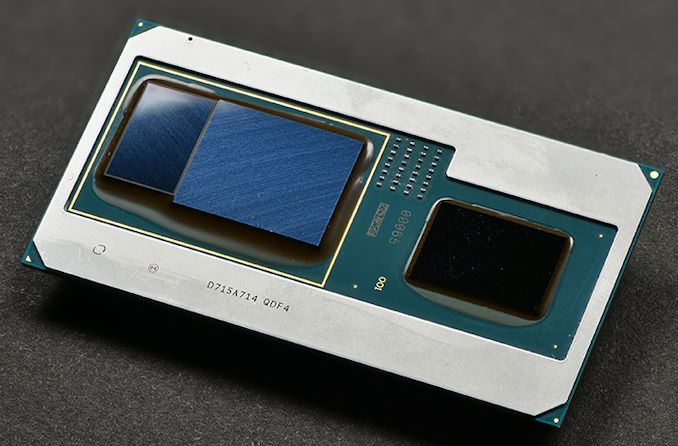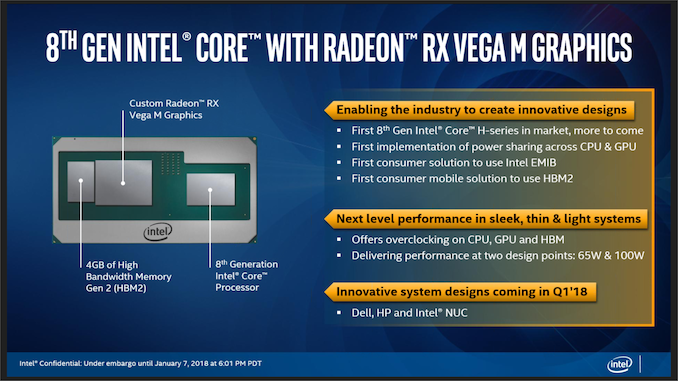Intel Kaby Lake-G GPU Driver Updates Left In Limbo, Currently Unsupported
by Ryan Smith on June 8, 2020 12:00 PM EST
While the retail shelf life of Intel’s unusual Kaby Lake-G processor has pretty much passed at this point, it looks like it has become the gift that keeps on giving when it comes to confusion about how support for the combined Intel/AMD chip will work. First spotted by Tom’s Hardware, AMD’s latest driver Radeon driver installer doesn’t include support for the chip’s AMD “Vega M” GPU, and as a result there are currently no up-to-date drivers available for the platform. And while Tom’s Hardware did get a cryptic-but-promising response from AMD about future driver support, for the moment it’s not clear what’s going to happen or how long-term driver support for the processor will work.
A one-off collaboration between Intel and AMD, Intel’s Kaby Lake-G processor combined a quad-core Intel Kaby Lake CPU with a discrete AMD Polaris-based GPU, all on a single package. With the AMD dGPU covering for Intel’s traditionally weak integrated graphics, Kaby Lake-G gave Intel and interesting chip that could deliver great compute performance and much stronger graphics performance as well.
However since the GPU portion of Kaby Lake-G came from outside Intel, the chip has always existed in an odd place where it’s never been fully embraced by either manufacturer. Even as an Intel-sold and Intel-branded product, Kaby Lake-G’s Radeon roots were never really hidden, and indeed the chip’s GPU drivers have clearly been a derivative of AMD’s standard driver set since the very beginning. But this has also meant that Intel has been reliant on AMD to provide those drivers, and for reasons that are not entirely public or transparent, this hasn’t been handled well. After a very long break between GPU driver updates, Intel essentially gave up on putting any kind of façade on the source of their GPU drivers, and began directing users to install AMD’s Radeon drivers, which at the same time gained official support for the chip.
And that was the end of that. Or so we thought.
Instead, as spotted by the Tom’s Hardware crew, Kaby Lake-G support has once again gone missing from AMD’s drivers. As a result, it’s not possible to install current drivers for the hardware – and even finding drivers that can be installed is a bit of an easter egg hunt.
When they reached out to Intel about the matter – and specifically, about updated drivers for Hades Canyon, Intel’s Kaby Lake-G based NUC – Tom’s Hardware did get a promising, but nonetheless cryptic response from the chipmaker:
And for the moment, this is where things stand, with no official explanation as to what’s going on. Driver support for Kaby Lake-G hangs in limbo, as Intel and AMD seem to be unable to sort out responsibility for the chip.
Joint projects like these are some of the most difficult in the industry, as having multiple vendors involved in a single product means that there’s some degree of cooperation required. Which is easier said than done when it involves historic rivals like Intel and AMD. Still, I would have expected that driver support is something that would have been hammered out in a contract early on – such that AMD was committed to deliver and paid for the necessary 5 years of drivers – rather than the current situation of Intel and AMD seemingly dancing around the issue.
In the meantime, here’s to hoping that Kaby Lake-G’s driver situation gets a happier ending in due time.
Source: Tom's Hardware











46 Comments
View All Comments
lmcd - Tuesday, June 9, 2020 - link
Nvidia's been trying to push POWER10 for this scenario but obviously that isn't an easy sell.jeremyshaw - Monday, June 8, 2020 - link
In the end, this was a marriage made in hell. Reminds me of the last Intel CPU + AMD GPU laptop I bought, all the way back in 2011: a Sony Vaio SC 13.Drivers stopped coming almost immediately after I bought the laptop. This was in the weird Win7->Win8 transition days, too, so getting drivers that worked for both OSes? Ha! The few Vaio SC 13 owners met online and discussed out options. Wen were lucky we could inf mod drivers back then in Win7, without incurring too much wrath of the driver signature validation gatekeeper in Win7, so that kept out laptops chugging for a little bit. It didn't take long before that stopped working with newer drivers and we were moribund until someone figured out binary mods (hex editing) to bypass the installation check. That worked for a few more driver releases until the laptop's AMD GPU stopped accepting any newer driver updates, whatsoever. Even inplace file replacements and registration stopped working (after 1 update? iirc). Newer games got glitchy real fast.
Eventually, I sold the laptop on that forum and bought it's newer, higher specced replacement in Sony's lineup: The Vaio S13, powered with Nvidia graphics (and Nvidia Optimus). Despite the experiences I just had, I was still a dyed in the wool ATi fanboi and flat out stupid for it. Let's just say, that laptop received working updates, DIRECT from NVIDIA for the next ~7+ years. Even Intel occasionally released CVE-relegated updates.
Every few years, I still buy an AMD Radeon GPU to test the waters. The last one I bought was the Thinkpad E485. AMD Ryzen CPU, AMD Vega GPU, on the same chip. No more excuses, right, AMD? SMH, AMD made of mess of that, too. AMD whined and blamed OEMs for not doing AMD's job, before finally sobering up and releasing driver updates themselves, as they should have. It only took 6 months before AMD stopped acting like a petulant little child.
Either way, I now am taking another 2-4 year hiatus from any AMD GPU purchases again.
Dragonstongue - Monday, June 8, 2020 - link
IMHO this is not AMD problem, but the seller overall, as AMD cannot support 3rd party driver sets as they can with their first party design (that is, AMD Radeon version XYZ by all means should be getting proper support and driver sets, whereas something from Lenovo cannot be directly supported via the same chain of drivers as they are not "verbatim" design..different wheels, cogs, power limits etc etc)Now if AMD made the laptop, was a full AMD branded product and they were to have done similar level of crud, then absolutely get right @#$ about it, I would, though when it comes to an ODM/OEM/AIB whatever you would like to call it, the same rules simply cannot apply, they simply do not.
Look at all mighty Intel, they are very adamant about how they do things, a much much larger company, yet even they do not give the same first party support to even full Intel branded designs
ahh well, get the product, use the product, hope it works properly right off the bat and will for a number of years till it gets replaced..these things are always a very hit and miss thing, even more so when the maker (Lenovo, Sony what have you) want you to buy it, but then they really do not at all support it the way they should be.
I personally hate it, only 2 choices, buy it and deal with the crap that likely will happen at some point, or do not buy at all and never have to deal with it ^.^
CiccioB - Tuesday, June 9, 2020 - link
This is a ridiculous justification. Nvidia supports its dGPUs mounted into 3rd party laptop. It's up to them to update the drivers for their own product.
Historically AMD has never been a good supporter of its own technology.
They tend to fire a new product and forget quite often. They are quite unreliable as partners and that's probably one of the reasons why no OEM wants to put their GPUs inside laptops. Despite the fact that those GPUs are also technically inferior to those of the competitor which also assures better support for years, not just weeks.
lmcd - Tuesday, June 9, 2020 - link
AMD changed that situation with regard to laptop drivers, and laptop manufacturers seem to support the change. I have the latest Radeon drivers on my 2700U laptop (which, granted, has plenty of other weaknesses).Sushisamurai - Tuesday, June 9, 2020 - link
I don't think it's a ridiculous justification - AMD gives the OEM a range of operating perameters, and the OEM chooses to go outside of reference for whatever reason. The stock drivers are for stock designs. I can't imagine AMD making an individual driver variant for every OEM variant of their chip. Case in point, my HP 15" Envy with an AMD Ryzen APU couldn't get the latest AMD drivers because not AMD, but HP blocked the install due to possible issues with incompatability. Luckily AMD changed that just recently.Sushisamurai - Tuesday, June 9, 2020 - link
IIRC, it's also the same with intel drivers for laptops. Last I checked, despite newer drivers for my other laptop's (HP) i7, I couldn't install them because the OEM did not validate the newer drivers as my laptop was cTDP up'd from the OEM, and ergo because it wasn't validated wasn't compatible with the install.mocseg - Monday, June 8, 2020 - link
Lenovo with apu 3500U & Linux here. Buttery smooth performance. Couldn't be happier.4000U series are even better.
boozed - Monday, June 8, 2020 - link
I don't think there are many happy stories out there that begin with "I bought a Sony VAIO laptop"Samus - Tuesday, June 9, 2020 - link
I think a lot of those issues could be summed up to Sony having historically poor support for their electronics, from phones to PC's.